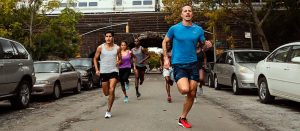
It’s a topic that has sparked controversy amongst running circles for years — should you train for your next race by running more miles at a slower pace or fewer miles at a quicker pace?
You may not be surprised, but the answer depends — both on an athlete’s physical proclivities, as well as their personal running goals. It’s not a one-size-fits-all solution. A high-intensity training plan that works for one runner will likely need to be repurposed to work for another. Each focus has its pros and cons and needs to be applied differently to work. Long story short, if you want to snag a PR at your next race, finding the right training balance that works for you — and staying consistent — is imperative.
DEFINING VOLUME AND INTENSITY
“Volume is the total number of hours or miles to be completed in a week,” says Brady Hoover, Ironman certified coach, ACSM certified personal trainer and EventHorizon coach, “Volume can then be looked at on a larger scale, say monthly or yearly volume when looking at a runners annual training plan.”
For example, a volume-based workout would look like this:
- Warmup: 10 minutes
- Workout: 40 minutes running at a comfortable, conversational pace
- Cool down: 5–10-minutes
On the other hand, intensity is less about the number of miles, but how much you put into those miles. “Intensity is simply how the athlete feels during a given workout. Intensity can be put on a scale of rate of perceived exertion from 1–10, with 1 being something like a walk, and 10 being a very intense sprint where the athlete is going all-out for 45 seconds or less,” says Hoover. At the other end of the spectrum, he mentions that low-intensity should feel very easy and sustainable — the more uncomfortable an athlete begins to feel, the higher the intensity.
For example, an intensity-based workout would look like this:
- Warmup: 10 minutes
- Workout: 4 minutes at the fastest pace you can sustain for 4 minutes. RPE should feel like a 10 out of 10 by the final 15 seconds. Five-minute recovery. Start off by walking and then building back into a slow jog. You want to feel fresh and ready to tackle the next working interval. Repeat 4 times.
- Cool down: 10-minutes
This workout would be an example of one that can be done once a week by a properly conditioned athlete. This sort of effort is excellent for increasing a runner’s V02 Max.
HOW THESE TRAINING METHODS AFFECT THE BODY
A volume approach allows the runner to build a foundation on which they can then take on more training stress. By increasing volume over a period of weeks, a runner starts to become stronger and adaptations occur, says Hoover. Ultimately, if the runner stays consistent, the speed at which they can run a 5K, half- or full-marathon will increase over time just by sticking to a pace that feels comfortable.
The intensity approach is a way of increasing running speed over a shorter period of time. By taking an intensity-based approach we begin to get the body more comfortable running faster paces. “Running at or above threshold pace allows a runner to develop the pace that feels ‘comfortable’ to them over a shorter period of time,” says Hoover.
HOW TO USE THESE APPROACHES TO GET FASTER
Both approaches are useful for getting faster. “To build on intensity, one must first build a foundation,” says Hoover. “If a runner is coming out without much volume and looking to build speed, I would have them first build running volume by starting the build-cycle with some low-intensity running to build endurance. From there we can start sprinkling in different intensities based on the athlete’s goals and their ability to handle certain forms of intensity.”
It helps to determine your goal. “I like to look at past performances as well as have the athlete do a 20-minute threshold test,” says Hoover. “I don’t want the athlete to start out too fast and then bonk in the final five minutes, but rather see them build consistently during the effort. When the athlete finishes the test I am able to get a threshold pace as well as a threshold heart rate. I then use these results to assign target heart rates and/or paces for certain runs.”
Once the endurance foundation is set, it’s time to determine specific intensity intervals, says Hoover. Obviously a marathon is run at a much slower pace than a 5K. For example, I wouldn’t have a marathon runner spending a lot of time on the track running 400s and 800s, instead we would be focusing more on time-based intervals like 4-minute best effort intervals at a target pace.
WHAT’S THE IDEAL BALANCE?
Hoover says he’s seen the best results when following the 80/20 (polarized training) approach, where 80% of the weekly volume is low on the intensity scale and 20% is higher intensity.
“I like to break this down a little further stating that really, 80% of the training volume should be low intensity, or below a determined threshold, 10% being moderate intensity (tempo running at slightly above the athlete’s determined threshold) and 10% high-intensity or very intense exercise above threshold doing 3–4 minute VO2 max intervals,” he says.
As seen on blog.mapmyrun
